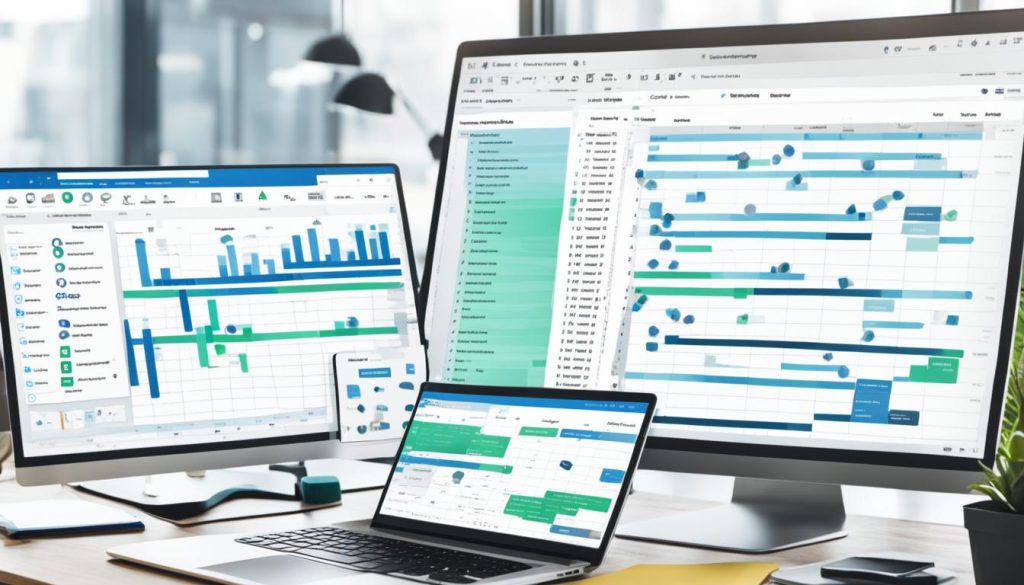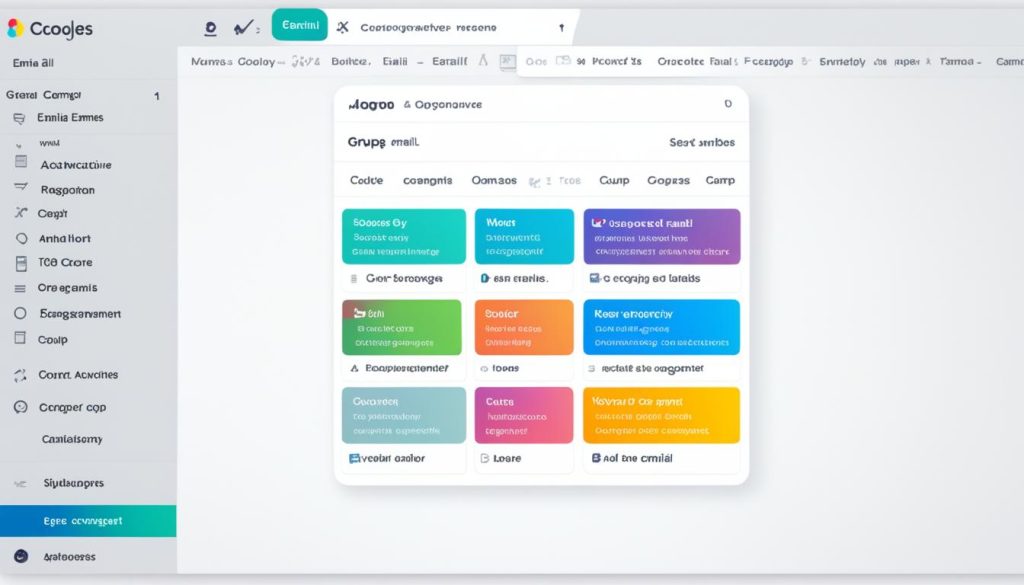In digital marketing, managing your email list well is crucial for success. How do we keep our email lists active and rewarding? It’s all about using the right tools and plans. These can help with things like grouping subscribers and keeping lists tidy.
When looking at email list tools, a key question often pops up: What are the top tools that can help us stay on top of our subscriber lists and drive better results? This guide will look into various email marketing tools. These tools can really change how we handle contacts, segment our readers, and personalize our messages.
Introduction to Email List Management
Email list management is about handling email subscribers on your lists in an organized way. It’s about knowing your audience better, especially the groups that benefit your business most. This approach ensures you have accurate data. It also lets you send emails that feel more personal, helping you earn more from your campaigns.
Importance of Maintaining an Engaged Email List
Keeping your email list up to date is key to reaching more inboxes and spending less. Currently, there are over 4 billion email users globally, and this number is set to rise. When your list is engaged, you get better returns from email marketing. But if you don’t manage it well, you may notice more emails bouncing back, people unsubscribing, and some emails marked as spam. This can hurt your ROI.
Benefits of Effective Email List Management
Handling your email lists correctly gives you deeper insights into your customers and helps you create focused segments. This means you can send emails that really speak to your audience, boosting engagement. Proper list management also ensures your emails make it to people’s inboxes and not the spam folder. It builds a better experience for your customers, helping your business grow and keeping you safe from violating the CAN-SPAM Act.
Best Practices for Email List Management
To make your email marketing work well, you need to manage your email lists right. We will cover three key tips to use. These will help you make better signup forms, check new subscribers, and welcome them with great emails.
Optimizing Signup Forms for Consent and List Quality
When you set up signup forms, tell users clearly what they’re signing up for. Only ask for necessary info and get clear permission for marketing emails. It’s a good idea to use a confirmed opt-in method. This makes sure the emails you get are valid, which builds a strong list and boosts your email reputation.
Implementing Double Opt-In for List Verification
Double opt-in is the best way to manage email lists. With this method, after signing up, new subscribers have to click a link in an email to confirm. This step proves they’re really interested in what you offer. It makes your list higher in quality. This also shows email providers you follow the rules and aim to keep a good audience.
Creating Engaging Welcome Emails for New Subscribers
Sending a great welcome email or a series of them can help a lot. It confirms their subscription and starts a good relationship with your brand. These emails make new subscribers feel special and want to connect with you more. By offering helpful info or special deals, you can begin on a positive note and build long-term connections.
Top Tools for Managing Email Lists
Want to get big returns from email marketing? You need top-notch email list management tools. The right email marketing software makes managing contacts simpler. It allows us to group our audience and send personalized messages. This boosts leads and earnings. Leading the pack are Moosend, HubSpot, Constant Contact, Paperform, ZeroBounce, Mailchimp, ActiveCampaign, and Brevo (formerly Sendinblue).
These tools come packed with helpful features. They make email management easy. From slicing up your list to automated emails, they have you covered. You can also craft beautiful opt-in forms, track how well your emails reach people, and test different versions of your content. With these tools, conquering your email marketing is possible. Plus, they help you follow GDPR rules and get better campaign results.
Moosend: Sophisticated Segmentation and List Hygiene
Moosend is a key player in email marketing platforms. It gives us high-end list segmentation tools for precise targeting in our emails. We use tags and data to send personalized content to subscribers. This means our emails have a 98% chance of landing in inboxes, not spam boxes.
Moreover, Moosend connects with top email verification services. This partnership helps keep our email lists clean. It means we can expect better results from our email marketing as we take care of our sender reputation.
HubSpot: All-in-One CRM and Email Marketing
HubSpot is more than just a marketing tool. It offers a powerful CRM system. This keeps you connected with your audience and organizes your email lists easily. With HubSpot, you can send emails that target different people or stages in their life. It also keeps your contact info updated across different apps. Plus, you get A/B testing and detailed analytics to refine your email marketing strategies.
A HubSpot study found that using targeted email campaigns led to a 77% rise in customer engagement. Users of HubSpot CRM had a 46% better email open rate than others. Among HubSpot users, those who tried A/B testing in emails saw a 30% improvement in conversion rates.
HubSpot’s email tools can cut manual work by 32%, boosting productivity. Businesses using these tools achieved a 25% better ROI over traditional email methods. Also, HubSpot CRM helped keep 20% more subscribers than the norm, showing its value.
Emails sent through HubSpot had a 15% higher response rate than usual, as per a study. This shows that HubSpot CRM and email marketing together are a powerful combo. They help businesses succeed in managing email lists and getting better results from campaigns.

Constant Contact: Basic List Management for Beginners
Constant Contact is a simple email tool for making newsletters. It has segmentation features to help you start. You can find contacts based on field values or actions like opens. You can organize contacts into email lists or export for specific campaigns.
If your business has a small email list, Constant Contact works well. For bigger lists, consider top Constant Contact alternatives. These might have more features for managing lists, like detailed subscriber segmentation and email automation.
| Constant Contact Features | Benefits |
|---|---|
| Basic list segmentation | Allows you to group subscribers based on contact field values and user actions |
| Email list creation and export | Enables you to organize your contacts and target them with relevant campaigns |
| Simple email newsletter builder | Helps you create and send professional-looking email newsletters with ease |
| Limited A/B testing and email analytics | Provides basic insights to optimize your email campaigns |
Although not the most advanced, Constant Contact is good for beginners. It’s easy for small businesses and meets GDPR compliance. As you get more contacts, you might want to look at other software for better management and automation.
Paperform: Beautiful Forms for List Building
Paperform is a top-notch contact list management tool. It lets you make landing pages and forms for signing up for your newsletter. You’ll find many stunning templates that help you get people’s email addresses. These forms are easy to adjust. You can add images or videos to draw more attention.
Customizable Templates and Integrations
With Paperform, you can set up logic rules. These rules decide when to show questions or new pages to visitors. It also connects with many apps, which makes gathering contacts easier. You end up making forms that look good and play well with your email marketing strategy.
Using Paperform gives you the power to customize and connect. This helps you build an effective email list. Your list will work smoothly with your email marketing tools. Plus, it keeps your contacts organized and ready for messages that convert well and follow GDPR compliance.
ZeroBounce: Email Verification and Spam Protection
ZeroBounce is an email verification tool. It ensures our emails get through, even when we send a lot. This tool removes bad email addresses, lowers our bounce rate, and keeps our sender score high. With an inbox placement tester, it checks our emails against spam filters. It also confirms IP addresses and checks the details of email recipients for more successful email campaigns.
ZeroBounce is great for checking big email lists with 99% accuracy. Its detailed evaluation system marks each address with specific status codes. Also, ZeroBounce Score uses AI to give emails a score from 0 to 10. This score helps guess how active the recipients are likely to be.
ZeroBounce watches over 200 blacklists 24/7 to keep our domain and IP clean. Its free analysis quickly shows how healthy or unhealthy our email list is. It’s smart to use this tool regularly to know when to clean your email list.
This tool is perfect for companies that send a lot of emails at once. ZeroBounce helps us manage our email lists better, improve how many emails get through, and run more effective campaigns.
Mailchimp: Intuitive Segmentation and Audience Insights
Mailchimp is famous for its email marketing tools. It has advanced A/B testing and works well with RSS campaigns. The real highlight is its segmentation. You can group your subscribers by mixing up to five conditions. This helps organize your audience using info like how they’ve acted, their demographics, and how much they’re involved.
It doesn’t stop at just sorting. Mailchimp gives us details about our subscribers. This info is key for making emails that really speak to different groups. Although lists in Mailchimp are kept separate, many people use it because it’s known for its effective tools.
| Feature | Mailchimp | Competing Platform |
|---|---|---|
| Segmentation Capabilities | Combine up to 5 conditional relationships | Limited to basic demographic and behavioral segmentation |
| Audience Insights | Detailed audience data and analytics | Basic reporting and audience insights |
| Email Campaign Types | Robust options including A/B testing and RSS campaigns | Fewer campaign types and limited testing capabilities |
| List Management | Siloed lists, no collective management | Integrated list management across multiple lists |
Mailchimp has some list management limits. But, its strong segmentation and audience insights are hard to beat. With Mailchimp, we can better manage our lists and send emails that truly resonate with our subscribers.
ActiveCampaign: Advanced Tagging and Automation
ActiveCampaign is made for perfecting sending emails. It helps us group our audience with tags. This means we can aim our emails better. The tool can add tags itself when people do things on our site. This beats Mailchimp at getting our emails in people’s inboxes, even though it’s a bit tricky for new users. Yet, it’s great for making managing email lists easier.
ActiveCampaign has won the trust of brands in 170 countries, with over $7,840 in sales. It offers 900+ ways to work with other apps. Using its smart ways to group and send emails can boost how often people interact with our emails by 47%. It can also increase how often people click our links by 786% in 3 months. Plus, we could see 10% more people willing to get our emails every month. This all helps us reach more and connect better with our audience.
| Key Metric | Result |
|---|---|
| Total Sales | $7,840 |
| Countries Served | 170 |
| Native Integrations | 900+ |
| Increase in Share of Tickets Purchased Online | 233% |
| Email Interaction Rate | 47% |
| Increased Click-through Rate (first 3 months) | 786% |
| Increase in Monthly Email Subscriptions | 10% |
Brevo (formerly Sendinblue): List Hygiene and Deliverability
Brevo, once called Sendinblue, is a great choice for free email marketing services. It helps create email campaigns and manage lists well. The service can spot unengaged subscribers and soft bounces. It uses data to group subscribers by certain traits. Brevo’s high sender score keeps emails out of spam and inboxes.
A clean email list leads to more emails getting delivered. Cleaning the list boosts your name as a sender. This makes it less likely for your emails to be marked as spam. It also grows how many people open and click through your emails. Keeping your lists clean enhances your marketing measures and keeps subscribers happy.
Experts suggest cleaning lists every half year to a year. Brevo comes in handy for this because it finds those who aren’t active. Sending re-engagement emails is a helpful way to get these people back to opening your emails.
Making people opt-in again pushes them to show interest. It’s also vital to let people unsubscribe easily. This keeps your mailing list free from uninterested parties. Knowing why emails bounce, especially in business emails, is key to a clean list.
Using double opt-ins and sending welcome emails or fun content improves list health and how people interact with emails. With Brevo’s help, managing email lists becomes easier. This allows for sending campaigns that perform well and feel personal to your audience.
Tools for Managing Email Lists
Choosing the best email marketing software is key for handling your email lists well. Make sure it matches your budget and what you know. It should have important features like customization, smart automation, and a user-friendly design.
Importance of the Right Email Marketing Software
The software you pick makes a big difference in how well you manage your emails. A good tool lets you group your audience, do list tasks automatically, and make your emails personal. This leads to more people getting involved and better results for you.
Key Features to Look for in List Management Tools
Look for tools that offer advanced segmentation, automatic list upkeep, and protect from spam. Also, find those that let you personalize emails and give you deep insights through analytics. These features keep your email list in top shape and make your marketing better.
By picking out the right email software with the best list tools, you can get to know your audience. This means you can send emails that are just right for each person. As a result, your email campaigns will do much better than before.

List Segmentation for Personalization and Engagement
Managing email lists well means breaking your audience into smaller groups. This helps make emails more personal and interesting. Using smart ways to divide your readers can make your emails more engaging. This, in turn, can bring more profits to your company.
Types of Segmentation: Demographic, Geographic, Behavioral
Segmentation can be based on demographics, psychographics, behaviors, and locations. Demographics look at age, gender, and education. Psychographics focus on beliefs and lifestyles. Behaviors track what they do online. And, location segmentation targets people by where they are.
Examples of Successful Segmentation Strategies
Sending different recommended products based on age is a prime example. Plus, tailoring your emails with local deals using geographic data can be a game-changer. For those further along in the buying process, setting up automated emails that understand their actions is key.
When we apply the right segmentation methods, we craft emails that truly speak to our readers. This boosts their interest and can lead to better results for our brand.
Re-Engaging Inactive Subscribers
Inactive subscribers in your email list deserve a second chance. Don’t dismiss them at once. Want to try and get them back? Start by setting up a way to reach out through your Tools for Managing Email Lists.
A smart move is to use behavior-based automated messages. These are for those who haven’t opened your emails for a while. It’s a way to send updated and relevant info without much effort on your part.
Behavior-Based Automated Sequences
Remind your fellow subscribers about the good stuff you offer. Send them a series of auto emails that start with something like, “Hey, long time no see.” These can include your newest items, services, or useful info. You might just get them to click again.
Exclusive Offers and “Miss You” Campaigns
Want them back more quickly? Try giving them special deals or discounts. This could be the nudge they need to come back. Emotional campaigns can work great too. Tell them you’ve missed them. Let them know they’re missed. This personal touch might just do the trick.

Using Tags for Dynamic Personalization
Tags are great for keeping your email lists organized and personal. Programs like Moosend, HubSpot, and Mailchimp let you use tags to make your emails stand out. Including a person’s name or where they live in your email’s subject or greeting can make them feel closer to you. This makes them more likely to open or click on your email.
Leveraging Tags in Email Campaigns
Using tags to personalize emails can really make them work better. With tags, you can tailor the subject line, greeting, and content to each person. This makes your subscribers feel like you really know them. They become more involved and are more likely to buy from you. Tags also help you sort your subscribers by their likes, actions, or details. This way, you send messages that are truly relevant to each group.
Examples of Personalized Subject Lines and Greetings
Here are some good examples of how you can use tags in subject lines and greetings:
- Subject line: “Hey [first_name], don’t miss our [product_category] sale!”
- Greeting: “Hi [first_name], we’ve got a special offer just for you!”
- Subject line: “Exclusive discount for our [location] subscribers”
- Greeting: “Greetings, [first_name]! Check out our latest [product_category] collection.”
By using the power of tags, your emails become more personal and exciting for your subscribers. This can lead to better results from your email marketing activities.
Maintaining a Clean and Engaged Email List
Keeping your email list clean is very important for marketers. A list full of bad emails can hurt your email marketing efforts. This includes your sender reputation and deliverability. To keep it clean and active, we need to regularly remove subscribers who don’t engage.
This way, we focus more on our active audience. It boosts our email campaigns by reducing costs. By pruning our list and keeping only the interested, we see better results. This includes higher email open rates and click-through rates, improving our email marketing ROI.
Also, having a clean list is key for GDPR compliance. It shows we care about our subscribers’ wishes. By cleaning out inactive emails, we protect privacy and strengthen our relationship with the audience.

